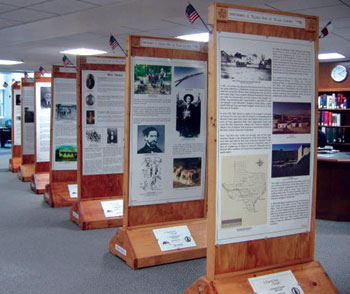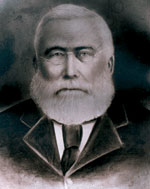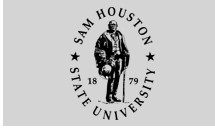Exhibit To Tell History Of 'Tejanos In Texas'
 |
| The "Tejanos In Texas" exhibit
focuses on the contributions made by Tejanos during the
first 200 years of Texas, long before Texans were remembering
the Alamo. |
When many people think of Texas history, they think of the
state’s Mexican rule and the Battle of the Alamo.
However, Mexico only ruled over Texas for 12 years, from 1824-1836,
and Texas as a province was founded in 1690, under the control
of Spain, according to Rudi Rodriguez, president and founder
of Texas Tejano, a San Antonio-based organization dedicated
to historical research and publications.
“In June of 1690, the famous explorer Alarcon came with
authority to proclaim this area as a new province of new Spain,
and he proclaimed it Tejas,” Rodriguez said. “The
local Indians are shouting Techas, and the Spanish interpret
that in writing as Tejas and Texas, as you can use the jota
(“j”) and the “x” as the same spelling,
and that’s where Texas gets its name.”
In recognition of the early Tejanos, the Sam Houston Memorial
Museum will tell the state’s life story through three
exhibits from Texas Tejano and a lecture entitled “Tejanos
in Texas.”
The exhibits will be on display in the Katy and E. Don Walker,
Sr., Education Center Gallery through April 30.
On Thursday (March 29), Rodriguez, a Texas historian for more
than 25 years, will discuss the Tejano background, the exhibits
and the work Texas Tejanos had done across the state during
the exhibit’s opening reception, from 5-8 p.m. in the
Walker Education Center Atrium.
“Texas history can never be complete without the story
of Tejanos being told,” Rodriguez said.
Tejanos, descendents of the first Spanish, Mexican and indigenous
families on the Texas frontier, have nothing to do with Mexico
as a country, Rodriguez said.
“It’s been a historical omission, but the Republic
of Mexico was not created until 1821,” he said. “The
other big misnomer is that anybody Hispanic in Texas was Mexican,
when the historical/chronological point is that Mexico doesn’t
get created until 1821.”
Two of the three exhibits, “Tejanos in Texas Heritage”
and the “Tejano Portrait Series,” focus on the
contributions made by Tejanos during the first 200 years of
Texas.
These contributions include establishing the first presidios
(forts), roads, governmental system and villas (towns), including
San Antonio (the capital for 130 years), Goliad, Victoria
and Nacogdoches.
“The first ranches along the Guadalupe River and the
Sabine River and the Red River and the Nueces River ultimately
produce the first ranching economy, and guess what they’re
harvesting on the ranches? Longhorn and mustangs,” Rodriguez
said. “The art of cowboying, if you will, has been in
existence for 150 years before the Battle of the Alamo, when
typically—when Texas history is written—it begins
in textbooks.”
 |
| Jose Policarpio "Polly" Rodriguez,
one of the state's first Texas Rangers. |
The final exhibit, “A Tejano Son of Texas Exhibit:
Jose Policarpio ‘Polly’ Rodriguez,” tells
the contributions and accomplishments of the man for whom
Polly, Texas, was named.
Among Polly’s accomplishments, he was an early Texas
gunsmith and surveyor; was a two-term justice of the peace
and county commissioner, as well as an election judge for
Bandera County; served with the legendary 2nd Cavalry, which
boasted such commanding officers as Robert E. Lee, Albert
Sidney Johnston and Joseph E. Johnston; helped create the
first school district and courthouse in the state; and was
one of the first Texas Rangers, according to Rodriguez.
After converting from Catholicism to Methodism, he became
one of the first 100 Methodist ministers in Texas and was
a circuit writer for the next 35-36 years of his life in Texas
and Mexico.
“The myth and lore in Texas Ranger history has never
cited Tejanos as members of, well, a lot of things, much less
the Texas Rangers,” Rodriguez said, adding that by today’s
standards, Polly would have been considered a founder and
charter member.
“I don’t know that they thought of themselves
as that (the first members); they were just doing the right
thing,” he said. “We have memoirs from various
men—not just Polly, but we certainly have his verbal
accounts where he says very modestly, ‘We were on the
frontier and because we were, the state allowed us to protect
our communities, so we grabbed our rifles and our horses and
went riding after bad guys and Indians.’
“But he never said ‘We were part of the elite
first Texas Rangers,’” he continued. “We
do that for them hundreds of years later.”
The mission of Texas Tejano, which was established four years
ago, is to bring awareness and education and help elevate
and celebrate the Tejano heritage and legacy in Texas through
its collections of artifacts.
“It’s one of a kind exhibit because we have probably
one of the only two exhibits that exist or that have ever
been done in the state of Texas,” Rodriguez said.
For more information on the exhibit, call the Sam Houston
Memorial Museum at 936.294.1832, and for more information
on Texas Tejano, visit http://www.texastejano.com/.
—END—
SHSU Media Contact: Jennifer
Gauntt
March 26, 2007
Please send comments, corrections, news tips to Today@Sam.edu.
|


